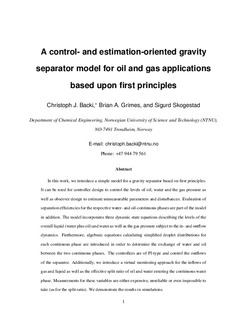| dc.contributor.author | Backi, Christoph Josef | |
| dc.contributor.author | Grimes, Brian Arthur | |
| dc.contributor.author | Skogestad, Sigurd | |
| dc.date.accessioned | 2019-05-14T08:50:08Z | |
| dc.date.available | 2019-05-14T08:50:08Z | |
| dc.date.created | 2018-04-28T16:57:56Z | |
| dc.date.issued | 2018 | |
| dc.identifier.citation | Industrial & Engineering Chemistry Research. 2018, 57 (21), 7201-7217. | nb_NO |
| dc.identifier.issn | 0888-5885 | |
| dc.identifier.uri | http://hdl.handle.net/11250/2597518 | |
| dc.description.abstract | We introduce a simple model for a gravity separator based on first principles. It can be used for controller design to control the levels of oil, water, and the gas pressure as well as observer design to estimate unmeasurable parameters and disturbances. In addition, evaluation of separation efficiencies for the respective water- and oil-continuous phases are part of the model. The model incorporates three dynamic state equations describing the levels of the overall liquid (water plus oil) and water as well as the gas pressure subject to the in- and outflow dynamics. Furthermore, algebraic equations calculating simplified droplet distributions for each continuous phase are introduced in order to determine the exchange of water and oil between the two continuous phases. The controllers are of PI-type and control the outflows of the separator. Additionally, we introduce a virtual monitoring approach for the inflows of gas and liquid as well as the effective split ratio of oil and water entering the continuous water phase. Measurements for these variables are either expensive, unreliable, or even impossible to take (as for the split ratio). We demonstrate the results in simulations. | nb_NO |
| dc.language.iso | eng | nb_NO |
| dc.publisher | American Chemical Society | nb_NO |
| dc.title | A Control- and Estimation-Oriented Gravity Separator Model for Oil and Gas Applications Based upon First-Principles | nb_NO |
| dc.type | Journal article | nb_NO |
| dc.type | Peer reviewed | nb_NO |
| dc.description.version | acceptedVersion | nb_NO |
| dc.source.pagenumber | 7201-7217 | nb_NO |
| dc.source.volume | 57 | nb_NO |
| dc.source.journal | Industrial & Engineering Chemistry Research | nb_NO |
| dc.source.issue | 21 | nb_NO |
| dc.identifier.doi | 10.1021/acs.iecr.7b04297 | |
| dc.identifier.cristin | 1582316 | |
| dc.relation.project | Norges forskningsråd: 237893 | nb_NO |
| dc.description.localcode | © American Chemical Society 2018. This is the authors accepted and refereed manuscript to the article. Locked until 24.08.2019 due to copyright restrictions. | nb_NO |
| cristin.unitcode | 194,66,30,0 | |
| cristin.unitname | Institutt for kjemisk prosessteknologi | |
| cristin.ispublished | true | |
| cristin.fulltext | postprint | |
| cristin.qualitycode | 2 | |
